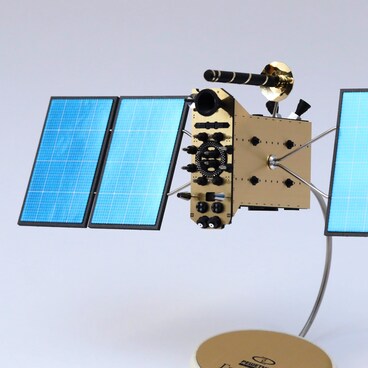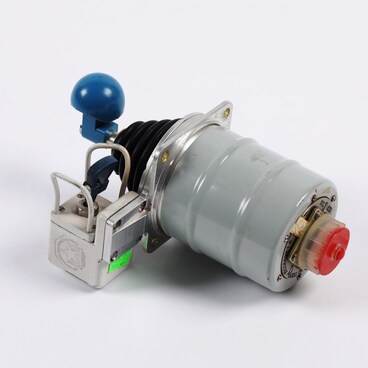Today’s spacecraft carry a huge amount of equipment that needs a supply of electricity in order to operate. This power is primarily supplied by solar batteries - blocks of connected photoelectric converters (PECs).
Fragment of a solar panel
Creation period
2017
Place of сreation
Zheleznogorodsk, Krasnodar Territory
Dimensions
60x67x3 cm
60 х 67 х 3 cm
60 х 67 х 3 cm
Technique
Industrial production
Collection
Exhibition
3
Open in app#1
Test panel for the Express-2000 Communications Satellite
#6
#7
Solar batteries are based on the photoelectric effect - atoms emit electrons when they are hit by light. The solar battery consists of a layered block of connected photoelectric converters. The bottom layer is made of pure crystalline silicon (or another semiconductor). The top layer is made of silicon with an admixture of boron or phosphorus. The boundary between the layers of pure and “impure” silicon has a blocking effect: electrons can only pass from the outer layer to the inner layer. The front of the structure is covered with a thin transparent metal plate, while the back is covered with a metal substrate. When light falls on the outer layer it passes through to the lower layer, and as a result an electric current is generated.
#8
The energy from solar radiation at the distance of the earth’s orbit is approximately 1340-1370 Watt per square meter. A silicon battery with an efficiency rating of 20% can therefore provide about 200 W per square meter. Modern batteries based on gallium arsenide (a compound of arsenic and gallium) can provide efficiency ratings of 32%.
#9
The photoelectric effect was discovered in the 19th century, and the first prototypes of solar batteries were made at the beginning of the 20th century, but they had an efficiency rating of about 1%. In 1948 staff at Bell Laboratories developed the first modern photoelectric converters. Within a few years they were already being used in the space sector. March 17, 1958 saw the launch of the first satellite with solar batteries — the American Vanguard 1. Within two months, on May 15, the first Soviet model fitted with solar batteries — Sputnik 3 — was launched.
#10
A modern solar battery element has a base made of carbon-epoxy tubes. Fibers are stretched across the base, and the PEC is attached to them. Modern PECs are triple-cascade photoelectric cells made of gallium arsenide, indium and phosphorous on a germanium base layer. In space solar batteries deteriorate, as they are continuously exposed to radiation (especially during solar flares), sharp fluctuations in temperature and the effects of meteoric dust. To protect them, PECs are covered with a layer of thin glass on both sides - 200 microns in front, and 10 microns at the back. The solar batteries have a service life of approximately 15 years, and this defines the service life of the satellite itself.
#11
This fragment of a solar battery was given to the museum in 2017 by the manufacturer to mark the opening of the Children’s Space Center in Kirov.
#12
Ministry of Culture of the Russian Federation
read morehide
00:00
00:00
1x
Fragment of a solar panel
Creation period
2017
Place of сreation
Zheleznogorodsk, Krasnodar Territory
Dimensions
60x67x3 cm
60 х 67 х 3 cm
60 х 67 х 3 cm
Technique
Industrial production
Collection
Exhibition
3
Open in app
Share



